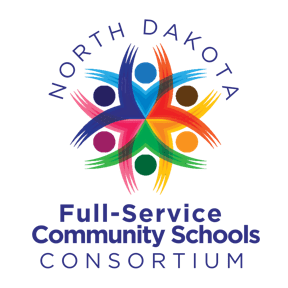IMPLEMENTATION JOURNEY
When the Griggs County Central Superintendent first started working at the school, it was siloed from the rest of the community, and no one seemed to have the time to cultivate connections that would open those doors.
“It was frustrating to see needs pushed to the side
because of time,” the Superintendent said.
Like many administrators, the Superintendent didn’t have the time needed to connect the school to the resources that exist to uplift and empower students. The school staff found themselves in the same situation. Time was already too precious, and adding and managing outside programming seemed like an impossible task.
But there was a solution: one that would place the school at the center of the community’s functioning and connect it to other North Dakota schools facing the same challenges. The district would be able to connect with schools that had already found solutions.
It was an educator from another school district who first told the Superintendent about the North Dakota FullService Community Schools (NDFSCS) Consortium. The educator shared how implementing the NDFSCS model had changed the landscape of their school and how their Site Coordinator had connected the school with its community, turning it into a hub of resources.
When a school joins the NDFSCS Consortium, a world of collaborative partnerships becomes available. By keeping Site Coordinators connected to each other, schools transition smoothly from a traditional model to a fullservice community school. As more schools join, Site Coordinators can share their knowledge, preventing new schools from fumbling in the dark.
The Superintendent saw the support that the Consortium offered its schools and how schools and communities supported each other. District leadership decided to implement the Full-Service Community Schools model, with the first step being to partner with the Consortium to hire a dedicated Site Coordinator to lead local efforts.
“Working with the Consortium was the perfect fit for all the right reasons,” the Superintendent explained.
Griggs County Central needed someone who already knew the school and the community. While there are many state-wide programs that empower students, North Dakota has a large amount of diversity. What works for one school may not work for another, and resources vary from community to community
Because the current Site Coordinator had worked as a school substitute prior to being hired at Griggs County Central, they were not a stranger to students, staff, or the community.
Griggs County Central began its implementation journey in the spring of 2023. During that first year, the Site Coordinator spearheaded initiatives that holistically “I’ve seen more of a bridge covering the gap for harder-toreach families so their kids have more capacity to engage in the academic world.” 2024 IMPLEMENTATION JOURNEY Website: griggscountycentral.org/ — Griggs County Central Site Coordinator As the North Dakota Full-Service Community Schools Consortium, we believe that students learn best when their basic needs are being met. We help coordinate comprehensive supports in areas such as wellness, workforce readiness, and academic enrichment to help students and families thrive. Visit ndfscs.org/schools to learn more. We partner with local leaders to coordinate comprehensive supports in areas such as wellness, workforce readiness, and academic enrichment to help students and families thrive. We are an organization of educators, health professionals, and parents. Above all, we are a group of people passionate about helping students and schools succeed. Students cannot learn when their basic needs are not being met, but not all schools have the resources to meet these needs. With NDFSCS, schools don’t have to navigate these challenges alone. served the school’s students. Like many rural communities in North Dakota, Cooperstown presents challenges in connecting with the community, as residents are often geographically spread out, living on ranches and farms.
Many rural schools, including Griggs County Central, joined the NDFSCS Consortium to try a new approach. These schools believe that serving the whole student, rather than focusing solely on academics, creates a stronger system, community, and future. Through their Site Coordinators, the NDFSCS Consortium schools connect with structured services and community resources.
Programs like their in-school food pantry and weekend BackPack Program, which sends hungry students home with food, are connected to the school through the Consortium. In fact, during the first year as an ND Full-Service Community School, the Site Coordinator’s dedication led to the implementation of the BackPack Program and the in-school food pantry.
Local community partners have strongly supported the Site Coordinator’s work at Griggs County Central, leading to even more opportunities. Their well-structured programs brought about an unexpected connection: when local ranchers saw her unloading a food truck from Great Plains Food Bank for the in-school pantry, they stopped to help. Week after week, they continued assisting. One day, they asked if they could donate some of their surplus beef to the students. The Site Coordinator agreed and now connects those ranchers to families, keeping the community engaged and involved in students’ lives.
“Since I started as Site Coordinator, I’ve seen more of a bridge covering the gap for harder-to-reach families so their kids have more capacity to engage in the academic world,” they explained.
This flexibility and community connection quickly establishes Site Coordinators as vital team members, turning the school into a hub for the community to uplift their youth while bringing valuable resources and programs through the doors. The connections that the Consortium fosters prove invaluable time and again.
“There’s peace of mind knowing that these needs are being addressed and knowing that we have a professional to help us do everything we can to meet people where they are,” the Superintendent said. “The opportunities that have opened up for the community have been a breath of fresh air.”

WHO WE ARE
We are an organization of educators, health professionals, and parents. Above all, we are a group of people passionate about helping students and schools succeed.

WHAT WE DO
We partner with local leaders to coordinate comprehensive supports in areas such as wellness, workforce readiness, and academic enrichment to help students and families thrive.



